Simple Erth Agriseeder drill transforms Perthshire farm’s pasture
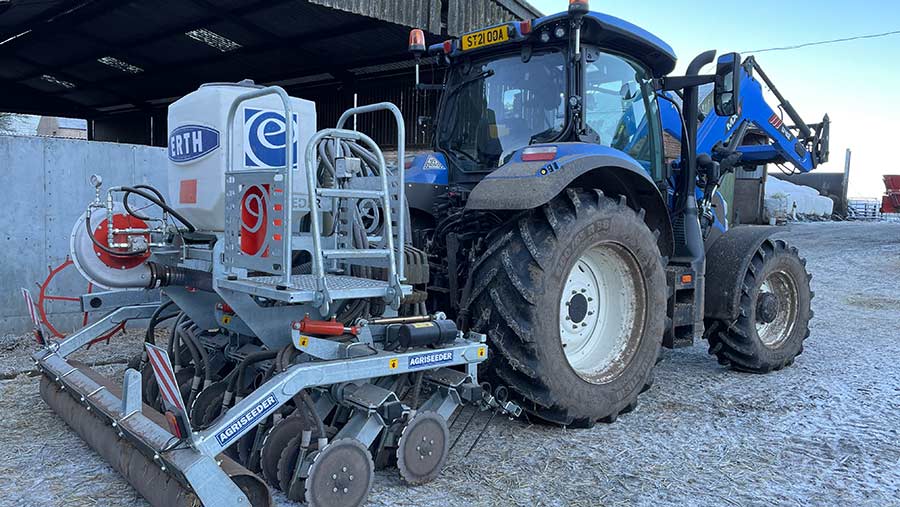 © Adam Clarke
© Adam Clarke In a bid to cut seed and fertiliser costs without sacrificing sward quality, Perthshire beef and sheep producer David Mitchell has pinned his hopes on an Erth Agriseeder direct drill and reckons it could be the perfect machine for pepping up tired grass fields.
Mr Mitchell has about 650ha of hill land and 140ha of upland permanent pasture to support his 900 Aberfield cross ewes and 170 Saler suckler cows with followers.
But with much of it on shallow, stony soil and steep slopes, it isn’t native habitat for a tractor and four-furrow plough – and that can make grassland management problematic.
See also: Overseeder options for perking up pastures
Farm Facts
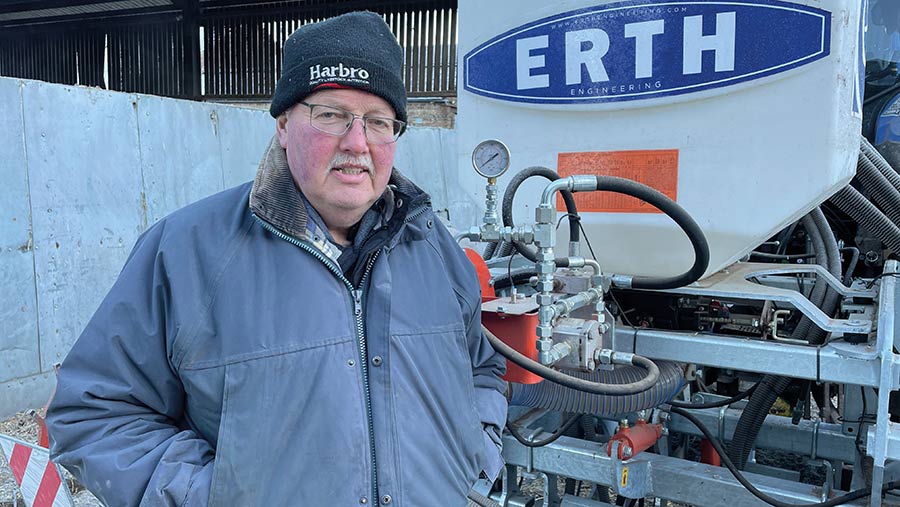
David Mitchell © Adam Clarke
- J&R Mitchell, Pairney Farm, Auchterarder, Perthshire
- Farm size 650ha hill land, 140ha upland permanent pasture and 100ha arable
- Livestock Flock of 900 Aberfield cross breeding ewes, 170 Saler suckler cows and followers, beef cattle finished in-house
- Staff David and Janie Mitchell, another full-timer and one self-employed shepherdess
Rather than spraying off with glyphosate and drilling into remnants of the sward, or ploughing down and starting from scratch, he now intends to rely on overseeding to rejuvenate his pasture.
This has the added benefit of reducing tillage and conserving soil carbon – something farmers in Scotland will soon be pushed to do anyway.
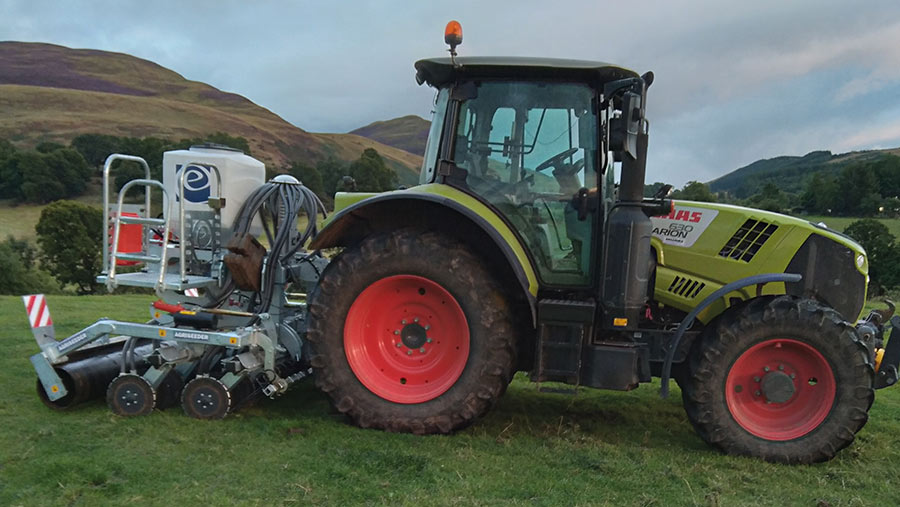
© Adam Clarke
Fertiliser savings
Opting for rejuvenation, rather than a total reseed, also allows him to cut back on expensive bagged fertiliser, as maintaining clover content can help fix atmospheric nitrogen and reduce required application rates.
He’d tried several methods over the years, including direct drilling with a tine-based machine, but this often gave unsatisfactory results due to inconsistent seeding depth.
Tine breakage on the stony ground was also a headache, as was the need to stone pick after pulling rocks to the surface.
Until last season, the system he’d settled on was surface seeding with an Opico Harrow and seed box. However, it was “hit and miss”, leaving his favoured ryegrass-clover rejuvenation seed mix at the mercy of the elements.
“Too much is left to chance and I’d been looking for a better solution for a while. I knew it had to be a disc drill of some kind,” says Mr Mitchell.
“Like everything else, grass seed is expensive now and you don’t want to be chucking it in the ground if it’s not going to grow.”
Highland inspiration
Before the Covid pandemic, he spotted the Agriseeder from Irish manufacturer Erth Engineering at the Highland Show and believed it to be the solution he’d been searching for. But, for several reasons, the purchase didn’t happen that year.
An updated version appeared at the first post-Covid Highland Show last June, and was attracting a lot of attention due to increased interest in reducing tillage across crop and livestock systems.
The sole UK agent for Erth is Northumberland-based Dales Agri Sales, and Mr Mitchell asked if they could get him a new machine by the end of July.
“Robert Taylor, the sales director, really pulled out all the stops and had our new drill delivered by the first week of August. In the current climate of long lead times, it was impressive,” he recalls.
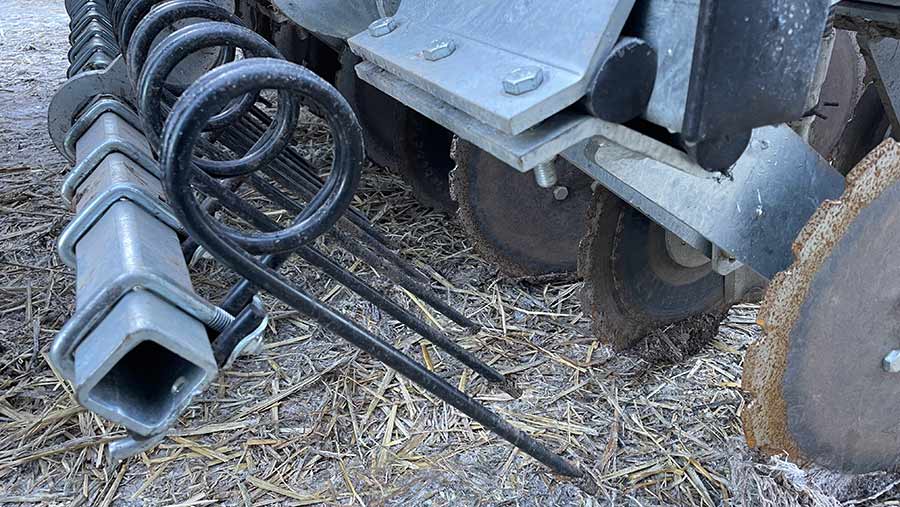
© Adam Clarke
What is it?
Most drills used for pasture rejuvenation have spring loaded coulter systems, but the high pressures required, and lack of frame flexibility, can result in uneven seeding depth across undulating or rough ground.
Erth’s Agriseeder is a direct disc drill that not only allows coulters to move independently on rubbers, but also on its secondary Autocontour hydraulic suspension system.
This sees the frame divided into eight sections across its 3m or 4m width, which float independently.
Each frame section has its own hydraulic ram, and these are linked together so that the pressure equalises as the drill rides across bumps and hollows.
The firm says this not only achieves better seeding depth – critical for rapid emergence of small-seeded species such as clover before vigour is lost – but also reduces the load on bearings and rubbers across the drill.
Its angled disc coulter system helps conserve moisture and improves root anchorage, reducing plant losses when stock grazing recommences.
The discs are 4.5mm Forge de Niaux boron blades with twin roller sealed bearings, and their pronounced disc angle reduces pressure on the seed coulter and leaves a neat finish on the surface.
Replaceable tungsten tile seed coulters sit lightly on the disc with a rubber washer in between. This helps keep the blade clean and prevents build-up of material between disc and coulter.
Mr Mitchell opted for a 3m, 24-row version (rows spaced at 125mm) with 400-litre plastic hopper. Metering comes from a simple ground-wheel-driven Kverneland Accord unit and he went for a hydraulically driven fan.
Erth does offer a 3m, 32-row option and a 4m, 32-row folding version. Buyers can also choose between a single or twin electric fan and electric metering unit.
In-cab control units range from a very basic area meter to a more complex unit with speed sensing that allows sowing rate to be changed on the move.
Further options specced by Mr Mitchell included an additional weight frame, a front harrow for clearing surface trash ahead of the discs and a galvanised finish, reducing corrosion risk after drilling into mucked ground.
How has it performed?
The drill was delivered by Dales Agri Services and married to the farm’s 130hp Claas Arion 630, although Mr Mitchell believes a 100hp tractor could easily cope with his 3m version.
Setup was extremely easy, he says, and he added some extra weight to the purpose-built frame.
“It was needed last year because the ground was so dry, but it was an exceptional season. I’ve seen the drill working fine without the extra weight elsewhere,” he adds.
The Agriseeder’s main job is pasture rejuvenation, but it has also direct seeded 12ha of short-term silage mix into a barley stubble and will be used for establishing brassica catch crops, too.
The rejuvenation mix was sown in August after sheep had taken the old sward back hard. They were then put back in to act as a harrow and roll, then taken out just before the seedlings came through.
“We didn’t go near it again for a few weeks and when we did go back, you could really see the fresh rows down the field.
“It’s safe to say it was very successful, but conditions couldn’t have been better. The mix was sown into warm, dry soils and we had some rain soon after. We might not always get the same level of success.”
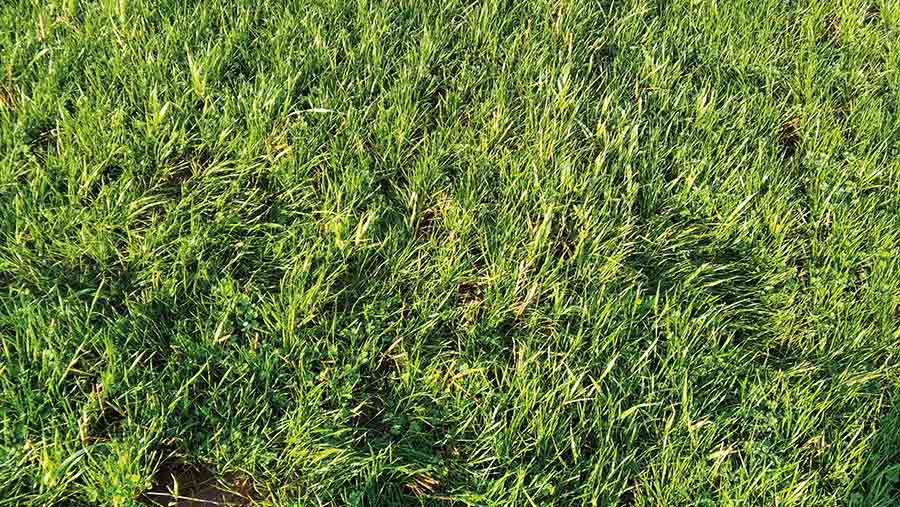
© Adam Clarke
Smooth floating
Similarly, the short-term silage mix was sown into stubble on his 100ha block of arable ground, which is used for rotational grass and cereals for cattle finishing.
It established quickly and evenly, helped by excellent conditions at barley harvest, so there were few combine tracks and no flat crop to contend with.
Mr Mitchell says the smooth floating of the three pressurised sections over the ground was noticeable during operation and for the little time he has so far spent using the machine, there are no gripes.
“I can only give myself and the drill so much credit, but I can say it’s the easiest bit of drilling I’ve done. The cost difference between the Agriseeder and ploughing and cultivating is significant, too.”
Going for the option of a front harrow was useful when working on the old sward, clearing enough thatch for the disc to cut cleanly into the soil and barely leave a mark after the drill.
He is also pleased with the Agriseeder’s relative simplicity, with no pto drive to worry about and hydraulics rather than electrics, which can be temperamental after a few seasons in harsh upland conditions.
“Someone has clearly put a lot of thought into its design. Although the Agriseeder is simple, it does exactly what I need and works very well.”
David Mitchell’s Erth Agriseeder specs
- Working width 3m
- Rows 24 at 125mm spacings
- Hopper 400-litre, plastic
- Metering Kverneland Accord mechanical
- Power required 100hp
- Features Hydraulically driven fan; extra weight frame; leading and rear tine harrows
- Price paid £23,000
